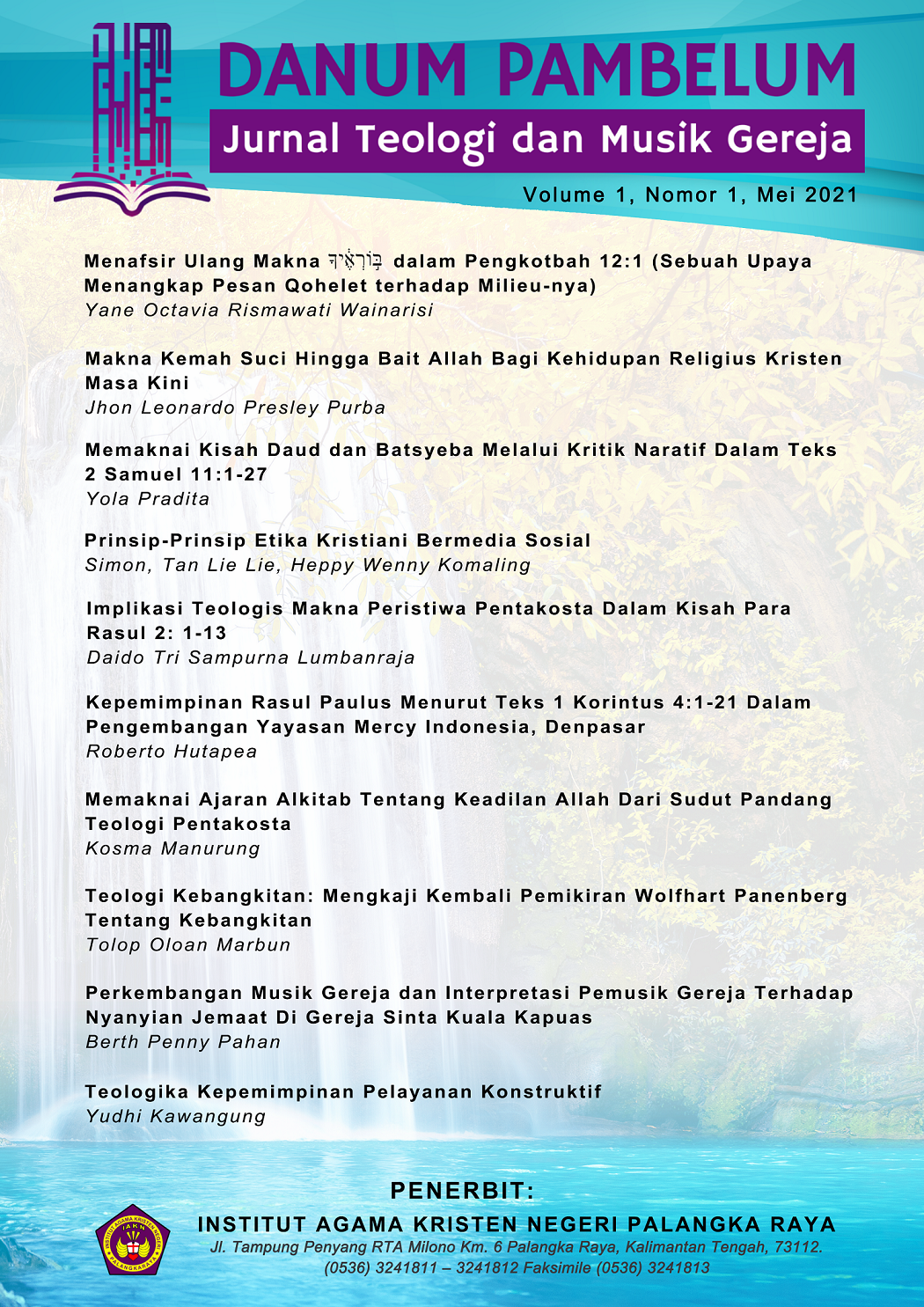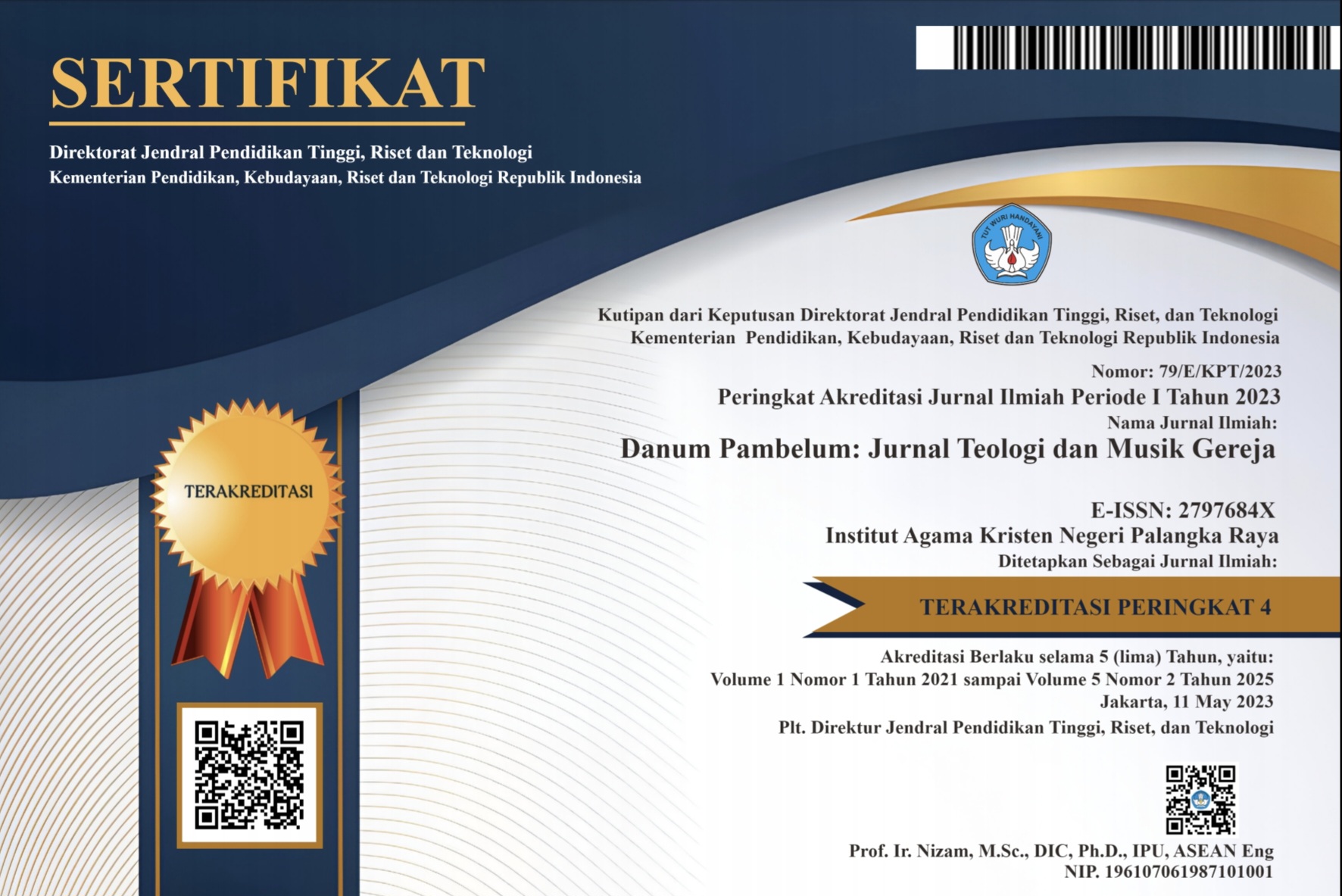Makna Kemah Suci Hingga Bait Allah Bagi Kehidupan Religius Kristen Masa Kini
DOI:
https://doi.org/10.54170/dp.v1i1.33Keywords:
bait suci, kemah suci, kristen, religiusAbstract
The religious life of today's Christians cannot be separated from the religious life of God's people in Old Testament times centered on the Tabernacle and temple. Therefore, this study aims to find and explain the meaning of the Tabernacle and the Temple for today's Christian religious life. This research is presented in descriptive qualitative form. The method used is literature studies to collect as many theories as possible from literature materials that correlate with research topics. The sources used are textbooks, physical or e-books, and journals. The results of this study show the Tabernacle of God, through Moses, speaks of the image of Christ in His journey, ministry and glory on earth. While the Temple, through Solomon, spoke of Christ in His ministry and glory in heaven. Implementation for Christians today, everyone must come to God through faith in Christ, Christians are the temple or dwelling place of the Spirit of God today, God is always present and leads the christian life, Christians must offer themselves to God and be His witnesses in the world.
Kehidupan religius orang Kristen masa kini tidak dapat dilepaskan dari kehidupan religius umat Allah pada zaman Perjanjian Lama yang berpusat pada Kemah Suci dan Bait Allah. Oleh karena itu, penelitian ini bertujuan untuk mencari dan menjelaskan makna Kemah Suci dan Bait Allah bagi kehidupan religius Kristen masa kini. Penelitian ini disajikan dalam bentuk kualitatif deskriptif. Metode yang digunakan adalah studi literature untuk mengumpulkan sebanyak mungkin teori dari bahan kepustakaan yang berkorelasi dengan topik penelitian. Sumber-sumber yang digunakan adalah buku teks, fisik atau e-book, dan jurnal. Hasil penelitian ini menunjukkan Kemah Suci Allah, melalui Musa, berbicara tentang gambaran Kristus dalam perjalanan, pelayanan dan kemuliaan-Nya di bumi. Sedangkan Bait Allah, melalui Salomo, berbicara tentang Kristus dalam pelayanan dan kemuliaan-Nya di surga. Implementasi bagi Kristen masa kini, setiap orang harus datang kepada Allah melalui iman dalam Kristus, orang Kristen adalah bait atau tempat berdiamnya Roh Allah saat ini, Allah senantiasa hadir dan menuntun kehidupan orang Kristen, orang Kristen harus mempersembahkan dirinya bagi Allah dan menjadi saksi-Nya di dunia.
References
Arifianto, Y. A. (2020a). Deskripsi Sejarah Konflik Horizontal Orang Yahudi dan Samaria. Pasca : Jurnal Teologi Dan Pendidikan Agama Kristen : Jurnal Teologi Dan Pendidikan Agama Kristen, 16(1), 33–39. https://doi.org/10.46494/psc.v16i1.73
Arifianto, Y. A. (2020b). Kajian Biblikal tentang Manusia Rohani dan Manusia Duniawi. Jurnal Teruna Bhakti, 3(1), 12–24.
Arifianto, Y. A., & Santo, J. C. (2020). Studi Deskriptif Teologis Pembangunan Bait Suci Orang Samaria di Gunung Gerizim. Jurnal Teologi Berita Hidup, 3(1), 66–80.
Beale, G. K. (2004). The temple and the church’s mission: a biblical theology of the dwelling place of God. In New studies in biblical theology.
Bloch-Smith, E. (2020). Solomon’s Temple: In Sacred Time, Sacred Place. https://doi.org/10.5325/j.ctv1bxh3xp.10
Bowo, T. (2020). Fungsi Bait Suci Bagi Umat Pilihan Allah. Sanctum Domine: Jurnal Teologi. https://doi.org/10.46495/sdjt.v8i2.50
Conner, K. J. (1988). The Temple of Solomon: The Glory of God as Displayed Trough the Temple. City Bible Publishing.
Flanders, Jr, Henry Jackson & Cresson, B. C. (1973). Introduction To The Bible. The Ronald Press Company.
Frey, A. (n.d.). Notes on The Tabernacle.
Garber, P. L., & Parrot, A. (1958). The Temple of Jerusalem. Journal of Biblical Literature. https://doi.org/10.2307/3264618
google. (n.d.-a). Herod’s Temple. https://images.search.yahoo.com/search/images;_ylt=Awr9DWvXczJgzWYAJjKJzbkF;_ylu=c2VjA3NlYXJjaARzbGsDYnV0dG9u;_ylc=X1MDOTYwNjI4NTcEX3IDMgRhY3RuA2NsawRjc3JjcHZpZANFdWpzSkRFd0xqSXJXc0JoWHpTOXhnYWdNVEUwTGdBQUFBRFlIRGp0BGZyA21jYWZlZQRmcjIDc2EtZ3AEZ3ByaWQDTTZz
google. (n.d.-b). Solomon’s Temple. https://images.search.yahoo.com/search/images;_ylt=Awr9FqwtbzJgXx8A9syJzbkF;_ylu=c2VjA3NlYXJjaARzbGsDYnV0dG9u;_ylc=X1MDOTYwNjI4NTcEX3IDMgRhY3RuA2NsawRjc3JjcHZpZANlMDI3U1RFd0xqSXJXc0JoWHpTOXhnUlZNVEUwTGdBQUFBQ1E4NWhGBGZyA21jYWZlZQRmcjIDc2EtZ3AEZ3ByaWQDXzA0
google. (n.d.-c). Temple Comparison. https://images.search.yahoo.com/search/images;_ylt=Awr9DWvXczJgzWYAJjKJzbkF;_ylu=c2VjA3NlYXJjaARzbGsDYnV0dG9u;_ylc=X1MDOTYwNjI4NTcEX3IDMgRhY3RuA2NsawRjc3JjcHZpZANFdWpzSkRFd0xqSXJXc0JoWHpTOXhnYWdNVEUwTGdBQUFBRFlIRGp0BGZyA21jYWZlZQRmcjIDc2EtZ3AEZ3ByaWQDTTZz
google. (n.d.-d). The Second Temple of Jerusalem. https://images.search.yahoo.com/search/images;_ylt=Awr9DWvXczJgzWYAJjKJzbkF;_ylu=c2VjA3NlYXJjaARzbGsDYnV0dG9u;_ylc=X1MDOTYwNjI4NTcEX3IDMgRhY3RuA2NsawRjc3JjcHZpZANFdWpzSkRFd0xqSXJXc0JoWHpTOXhnYWdNVEUwTGdBQUFBRFlIRGp0BGZyA21jYWZlZQRmcjIDc2EtZ3AEZ3ByaWQDTTZz
Hadiwijono, H. (1992). Iman Kristen. BPK Gunung Mulia.
Hill, Andrew & Walton, J. (2008). Survey Perjanjian Lama. Penerbit Gandum Mas.
Hinckley, R. (2013). Adam, Aaron, and the Garden Sanctuary. Reformation.
Homan, M. M. (2007). The Tabernacle and the Temple in Ancient Israel. Religion Compass. https://doi.org/10.1111/j.1749-8171.2006.00006.x
Jong, P. C. (2003). The Tabernacle: A Detailed Portrait of Jesus Christ ( II ). Hephzibah Publishing House.
Joseph, M., & Joseph, M. (2020). Tabernacles. In Judaism as Creed and Life. https://doi.org/10.4324/9781003023371-23
Killebrew, A. E. (2015). Jerusalem: Capital city created in stone and in imagination. In The Cambridge World History: Volume III: Early Cities in Comparative Perspective, 4000 BCE-1200 CE. https://doi.org/10.1017/CHO9781139035606.026
Loader, W. (2008). A Kingdom of Priests: Ancestry and Merit in Ancient Judaism. Journal for the Study of Judaism. https://doi.org/10.1163/157006308x375852
Lundquist, J. M. (2008). The Temple of Jerusalem: Past, Present and Future. Praeger Publisher.
Mangean, A. (2019). Pendekatan Historis Kristis Terhadap Bilangan 3 dan 4 tentang Tanggung Jawab Pendeta. BIA’: Jurnal Teologi Dan Pendidikan Kristen Kontekstual. https://doi.org/10.34307/b.v2i2.133
O’Collins, Gerald & Keenan Jones, M. (2010). Jesus Our Priest: A Christian Approach to the Priesthood of Christ. Oxford University Press.
Publishing, R. (2008). Rose Guide to the Tabernacle. Rose Publishing, Inc.
Snyder, H. G. (2011). Early christianity. In The Cambridge Companion to Ancient Mediterranean Religions. https://doi.org/10.1017/CCO9781139047784.012
Sprinkle, J. (2000). The Rationale of the Laws of Clean and Unclean in the Old Testament. Journal of the Evangelical Theological Society.
Tong, S. (2013). From Faith To Faith, Dari Iman Kepada Iman. Momentum.
Wasserman, J. (2011). The Temple of Solomon: From Ancient Israel to Secret Societies. Inner Traditions.
Zaluchu, S. E. (2020). Strategi Penelitian Kualitatif dan Kuantitatif Di Dalam Penelitian Agama. Evangelikal: Jurnal Teologi Injili Dan Pembinaan Warga Jemaat, 4(1), 28–38. https://doi.org/10.46445/ejti.v4i1.167
Zaluchu, S. E. (2021). Metode Penelitian di dalam Manuskrip Jurnal Ilmiah Keagamaan. Jurnal Teologi Berita Hidup, 3(2). https://doi.org/10.38189/jtbh.v3i2.93
אלוני, י., & Aloni, J. (1983). The Place of Worship and the Place of Slaughter According to Leviticus 17:3-9 / מקום הפולחן ומקום השחיטה לפי ויקרא יז ג-ט. Shnaton: An Annual for Biblical and Ancient Near Eastern Studies / שנתון לחקר המקרא והמזרח הקדום.






